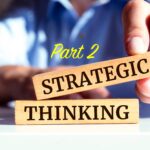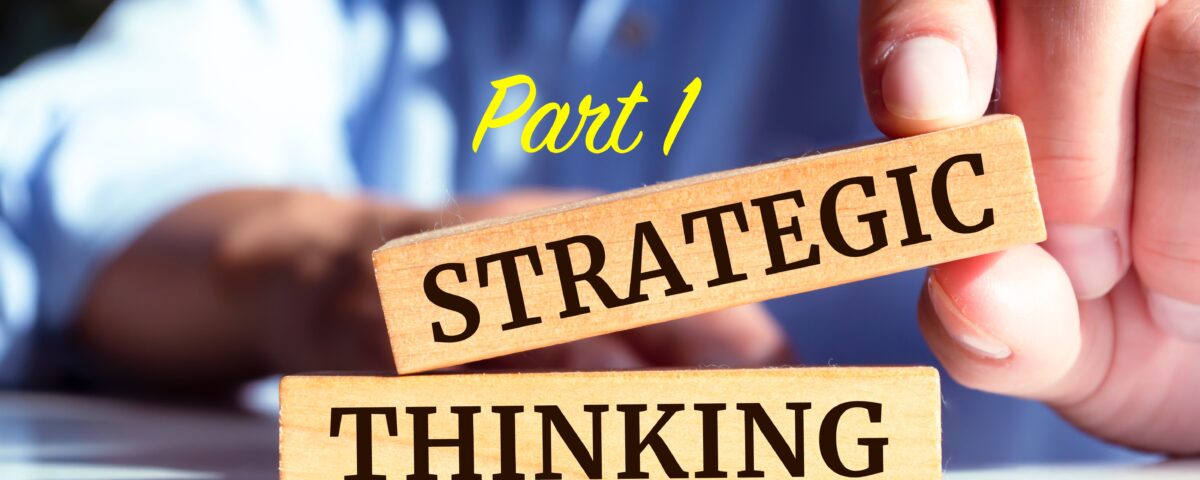
Technical Expert, But Can They Lead? How to Avoid Missteps in Manager Promotions
December 1, 2024
Strategic Thinking Essentials Part 2: Anticipation, Vision, and Risk Management Skills
February 4, 2025Strategic Thinking Essentials Part 1: Critical Thinking and Contextual Analysis Skills

In today’s rapidly evolving business landscape, strategic leadership is more crucial than ever. Business leaders must not only navigate daily operations but also steer their organizations toward long-term success in an environment characterized by increasing degrees of volatility, uncertainty, complexity, and ambiguity (VUCA). A well-defined strategy serves as a roadmap, guiding decision-making, resource allocation, and organizational focus in today’s dynamic and complex world.
Yet 85% of leaders in U.S. companies today don’t spend much time at all thinking about strategy, despite research showing that the main cause of prolonged financial decline by once-successful companies is poor decisions related to strategic factors.
Why is that? I’ve found it’s a combination of two reasons: they’re too busy putting out daily fires, and they need to better develop their strategic thinking skills.
I’ll talk about prioritization and time management in an upcoming blog post, but let’s begin with a three-part series unpacking seven strategic thinking skills that are essential for any company’s success:
- Critical Thinking
- Contextual Analysis
- Anticipation
- Vision
- Risk Management
- Learning
- Adaptability
In this post we’ll focus on the first two – critical thinking and contextual analysis. But first …
What is strategy?
The definition that I’ve found most useful is one I learned through my professional military education as a Marine: strategy is the careful integration of ends, ways, and means to create a competitive advantage. Ends are your overarching objectives. Ways are your methods for achieving those objectives. Means are the resources you need to execute the methods. And the competitive advantage you create hinges on how your ends, ways, and means differentiate you from your competition.
In business, “Strategy is about how a company creates value for their targeted customers and the relative position it occupies against competitors – it is external looking, and focused not on where the company is today, but where it will be positioned for success in the future,” says Tom Leppert, former CEO of multiple large companies and an experienced board member of several public and private international companies.
With this definition in mind, let’s dive into the first two essential strategic thinking skills.
#1 – Critical Thinking
At the heart of strategic thinking is critical thinking, which centers on understanding and challenging assumptions. Critical thinking is most effective in an environment that encourages diverse points of view to bring to the surface underlying assumptions that can be debated and discussed.
Take Netflix, for example, which was founded in 1997 as a mail-based DVD rental business using online ordering. At the time, Blockbuster dominated the home entertainment industry and was raking in $4B in annual revenue. Ironically, after the dot-com bubble collapse in 2001, Netflix’s founders tried to sell the company for $50M to Blockbuster, who laughed them off.
Netflix regrouped and developed a strategy to become a market leader in the industry using critical thinking to challenge the assumption that brick-and-mortar video rental stores were the way of the future. And it paid off. Today, Blockbuster is bankrupt and Netflix is the leading streaming platform in the U.S. with a market value of more than $370B.
Developing critical thinking skills within your team is essential for effective problem-solving and decision-making. Here are five ways you can foster these skills:
- Encourage Continuous Learning: Promote a culture where team members are motivated to expand their knowledge and stay informed about industry trends. This broadens their perspectives and enhances analytical abilities.
- Facilitate Open Dialogue: Create an environment that values diverse viewpoints and open communication. Encouraging team members to share their thoughts and challenge assumptions leads to more robust discussions and innovative solutions.
- Provide Training and Resources: Offer access to workshops, courses, and materials focused on critical thinking and problem-solving techniques. Structured learning opportunities can equip your team with the necessary tools to think critically.
- Model Critical Thinking: Demonstrate critical thinking in your decision-making processes. By showcasing how to analyze situations, evaluate options, and consider potential outcomes, you set a standard for your team to emulate.
- Encourage Reflective Practice: Prompt team members to reflect on their experiences and decisions. Reflective practice helps individuals learn from past actions and apply insights to future situations, enhancing their critical thinking capabilities.
Implementing these strategies can cultivate a team proficient in critical thinking, leading to improved collaboration, innovation, and overall performance.
#2 – Contextual Analysis
Understanding your operating environment is crucial for effective strategic thinking. A comprehensive analysis of “4 Cs” – Company, Customers, Competitors, and Climate – provides valuable insights that inform decision-making and strategy formulation.
Company: Begin by evaluating your organization’s internal environment, including its strengths, weaknesses, resources, and capabilities. This self-assessment helps identify core competencies and areas for improvement, ensuring that strategies are aligned with the company’s mission and objectives.
Customers: Understanding your target audience’s needs, preferences, and behaviors is essential. By analyzing customer demographics and psychographics, businesses can tailor their products, services, and marketing efforts to effectively meet demand, enhancing customer satisfaction and loyalty.
Competitors: Assessing the competitive landscape involves identifying direct and indirect competitors, analyzing their strengths and weaknesses, and understanding their market positioning. This analysis enables businesses to differentiate themselves and identify opportunities for gaining a competitive advantage.
Climate: This encompasses the broader external environment, including political, economic, social, and technological (PEST) factors. A PEST analysis can be employed to systematically evaluate these elements, helping businesses anticipate market trends and adapt strategies accordingly.
By thoroughly analyzing these four components of context, leadership teams can develop well-informed strategies that are responsive to both internal capabilities and external market dynamics, positioning your organization for sustained success. Returning to our earlier example, a key part of Netflix’s successful strategy to topple Blockbuster involved contextually analyzing how the digital revolution was drastically changing the operating environment.
Here are five ways to enhance contextual analysis within your team:
- Conduct Environmental Scanning: Encourage team members to regularly monitor industry trends, market dynamics, and emerging technologies. This practice helps them understand external factors that could impact the organization, fostering a broader perspective.
- Promote Systems Thinking: Train your team to view the organization as part of a larger system, recognizing how various internal and external elements interact. This holistic approach enables them to anticipate the ripple effects of decisions across different areas of the business.
- Encourage Scenario Planning: Engage the team in developing multiple scenarios based on potential future events. This exercise enhances their ability to anticipate changes and develop flexible strategies that can adapt to various contexts.
- Facilitate Cross-Functional Collaboration: Provide opportunities for team members to work with different departments. This exposure broadens their understanding of the organization’s operations and the interdependencies that exist, enriching their contextual awareness.
- Conduct Regular Debriefs: After completing projects or significant tasks, hold debrief sessions where the team reflects on what was learned about the operating environment. This reflection helps solidify their understanding of context and its importance in strategic thinking.
By implementing these practices, you can cultivate a team that is adept at understanding and leveraging context, leading to more informed decision-making and effective strategic planning.
Conclusion
In today’s dynamic business environment, cultivating strategic thinking skills is essential for leaders aiming to guide their organizations toward sustained success. By enhancing critical thinking and contextual analysis skills, leaders can make informed decisions that align with their company’s objectives and adapt to evolving market conditions. Implementing the strategies discussed – such as fostering continuous learning, encouraging open dialogue, and conducting comprehensive environmental analyses – can strengthen these competencies within your team. As we continue this series, we will explore the remaining strategic thinking skills, equipping you with the tools to navigate the complexities of today’s business landscape effectively.
Next month in Part 2 we’ll unpack essential strategic thinking skills #3-5, so stay tuned. In the meantime, if you need help developing leaders who can think more strategically, let’s chat.
Sources
Harvard Business School: What Is Business Strategy & Why Is It Important?
Journal of Accountancy: 5 Strategies to Grow Critical Thinking Skills
Deakin University: How Teams Should Approach Critical Thinking
Aaron Hall: Building Your Team’s Critical Thinking Skills for Success
Harvard Business School: 4 Ways to Develop Your Strategic Thinking Skills
Zenger Folkman: Developing Strategic Thinking Skills – The Pathway to the Top
Teach Educator: Teaching Critical Thinking Starts with the Student
V500 Systems: Blockbuster vs Netflix
